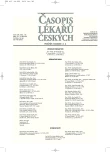-
Medical journals
- Career
The Use of Thrombelastography in Evaluation of Coagulation in Females with Physiological or Pathological Gravidity
Authors: F. Polák 1; M. Lipš 1; H. Bedřichová 1; P. Kříž 1; A. Pařízek 2
Authors‘ workplace: Klinika anesteziologie, resuscitace a intenzivní medicíny 1. LF UK a VFN, Praha 1; Gynekologicko–porodnická klinika 1. LF UK a VFN, Praha 2
Published in: Čas. Lék. čes. 2007; 146: 396-400
Category: Original Article
Overview
Background.
During gravidity changes in coagulation develop, however different norms for pregnant women and prevailing population are rarely used. Pathological gravidity can be accompanied with more significant coagulopathies. Thrombelastography is more and more frequently used for evaluation of coagulation parameters of pregnant women. The aim of the study was to compare thrombelastographic coagulation parameters in females with physiological or pathological gravidity and with norms for prevailing population.Methods and Results.
60 women in the 3rd trimester of physiological gravidity (group ZDRAVÉ) and 50 women with pathological gravidity (women with preeclampsia or with a dead fetus, group PATOL) were examined. Both groups were of the comparable age. Average values of studied parameters in the group ZDRAVÉ were found at the level of “procoagulation” limits for prevailing population. In the group PATOL, average values were even more “procoagulative”, however, differences to the ZDRAVÉ group were nor significant: time r 4.7 (SD 1.7) vs. 4.4 (SD 2.0) p=0.461 (norm for prevailing population 4–8 min), time to 1.5 (0.5) vs. 1.3 (0.4) p=0.030 (norm 1–4 min), angle alpha 69.6 (5.5) vs. 71.0 (7.7) p=0.324 (norm 47–74°), maximal amplitude 71.3 (4.5) vs. 73.1 (4.7) p=0.079 (norm 55–73 mm), coagulation index 2.7 (1.8) vs. 3.2 (1.8) p=0.219 (norm (–3)–(+3)). In the group PATOL higher variability than in the group ZDRAVÉ was found. On the basis of the group ZDRAVÉ selection percentiles, new norms of thrombelastographic coagulation parameters for pregnant women were elaborated.Conclusions.
Coagulation during pregnancy differs significantly from that of prevailing population. That is why the new thrombelastographic norms for pregnant women are submitted. Coagulation changes in pathological pregnancies are more difficult to anticipate than in healthy gestations.Key words:
thrombelastography, pregnancy, coagulopathy, preeclampsia.
Labels
Addictology Allergology and clinical immunology Angiology Audiology Clinical biochemistry Dermatology & STDs Paediatric gastroenterology Paediatric surgery Paediatric cardiology Paediatric neurology Paediatric ENT Paediatric psychiatry Paediatric rheumatology Diabetology Pharmacy Vascular surgery Pain management Dental Hygienist
Article was published inJournal of Czech Physicians

-
All articles in this issue
- Decompressive Craniectomy in the Treatment of Posttraumatic Edema and the Contribution of new Diagnostic Methods
- Milestones of Cardiovascular Pharmacotherapy: II. Digitalis
- Perioperative Betablockade
- Adjuvant Chemotherapy in the Treatment of Non-small Cell Lung Cancer
- Phytosterols as a Functional Food
- Genotype – Disease Association and Possibility to Reveal Environmentally Modifiable Disease Causes: The Use of Mendelian Randomization Principle
- How to Continue in the Treatment of Tuberculosis in the Czech Republic?
- Factors Modulating Parameters of Cholesterol Homeostasis in the Metabolic Syndrome
- Relation Between Alcohol Intake and Some Metabolic and Cardiovascular Risk Factors in the Healthy Men
- Practical Aspects and Clinical Value of t(14;18) Monitoring in Peripheral Blood of the Follicular Lymphoma Patients
- Effect of Surgical Treatment of Atrial Fibrillation on the Attainment and Maintenance of Sinus Rhythm in Patients Undergoing Concomitant Cardiac Surgery – Short-term Results
- The Use of Thrombelastography in Evaluation of Coagulation in Females with Physiological or Pathological Gravidity
- The Use of Paracetamol in Children –Benefits and Risks
- Indication to Occlusion of Patent Foramen Ovale in Patient with Pulmonary Hypertension after a Cardioembolic Stroke
- Journal of Czech Physicians
- Journal archive
- Current issue
- Online only
- About the journal
Most read in this issue- Adjuvant Chemotherapy in the Treatment of Non-small Cell Lung Cancer
- Indication to Occlusion of Patent Foramen Ovale in Patient with Pulmonary Hypertension after a Cardioembolic Stroke
- Phytosterols as a Functional Food
- The Use of Paracetamol in Children –Benefits and Risks
Login#ADS_BOTTOM_SCRIPTS#Forgotten passwordEnter the email address that you registered with. We will send you instructions on how to set a new password.
- Career

